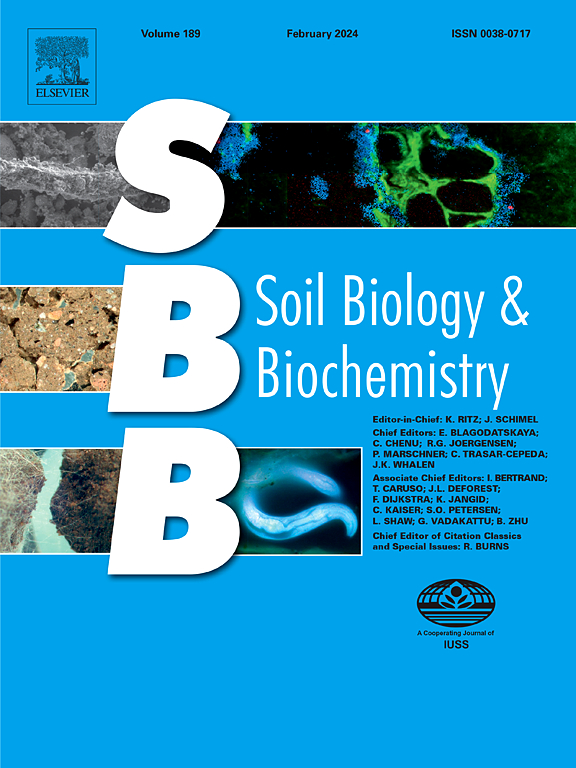Decoupling of heat and CO2 release during decomposition of cellulose and its building blocks in soil
IF 9.8
1区 农林科学
Q1 SOIL SCIENCE
引用次数: 0
Abstract
The degradation of large biopolymers, such as cellulose, in soil requires several enzymatic hydrolysis steps to produce simpler substrates for microbial uptake. The synthesis of these enzymes requires energy and takes time until they are fully expressed. However, the heat release associated with enzymatic hydrolysis and the temporal delay between this initial heat release and the final carbon mineralization to CO2 is largely unknown. In this study, we investigated the dynamics of heat and CO2 release during the sequential decomposition of cellulose to its building blocks, cellobiose and glucose, in soil and related these processes to activities of cellobiohydrolase and β-glucosidase driving the corresponding steps of cellulose decomposition. Moreover, we estimated catabolic heat release during the stepwise enzymatic production of oligo- and monomers in soil by employing fluorogenically labeled substrates. This amounted to the absolute value of 26.5 kJ mol C−1, approximately 6.5 % of the total combustion enthalpy stored in the applied cellulose.
By three complementary approaches, we confirmed that cellobiohydrolase rather than β-glucosidase is the bottleneck step of enzymatic hydrolysis. First, a 36 h temporal decoupling between the heat and CO2 formation peaks occurred during step-wise enzymatic hydrolysis of cellulose performed by cellobiohydrolase and β-glucosidase towards final mineralization. This decoupling was not observed in the next sequential step of cellobiose hydrolysis by β-glucosidase. Remarkably, heat and CO2 release evolved more slowly during cellulose degradation compared to that of its building blocks, cellobiose and glucose. Second, the enzyme activity of β-glucosidase more than doubled that of cellobiohydrolase during cellulose degradation. Third, heat release after the addition of flurogenically labeled substrate to soil, which mimics the steps of cellulose degradation, was faster in the step of glucose production than that of cellobiose production. This study highlights the novel mechanistic insights facilitated by calorespiroemetric monitoring of carbon decomposition at high temporal resolution.
土壤中纤维素及其组成部分分解过程中热量和二氧化碳释放的解耦
降解土壤中的大型生物聚合物,如纤维素,需要几个酶水解步骤,以产生更简单的底物供微生物吸收。这些酶的合成需要能量和时间,直到它们完全表达。然而,与酶解相关的热释放以及这种初始热释放与最终碳矿化成二氧化碳之间的时间延迟在很大程度上是未知的。在本研究中,我们研究了纤维素在土壤中依次分解为纤维素二糖和葡萄糖的过程中热量和CO2释放的动态,并将这些过程与驱动纤维素分解相应步骤的纤维素生物水解酶和β-葡萄糖苷酶的活性联系起来。此外,我们估计分解代谢热释放过程中逐步酶法生产的低聚物和单体在土壤中使用氟标记的底物。这相当于26.5 kJ mol C-1的绝对值,约为所施用纤维素中储存的总燃烧焓的6.5%。通过三种互补的方法,我们证实了纤维素生物水解酶而不是ß-葡萄糖苷酶是酶解的瓶颈步骤。首先,在纤维素生物水解酶和ß-葡萄糖苷酶对纤维素进行逐步酶解以达到最终矿化的过程中,热量和二氧化碳形成峰之间发生了36小时的时间解耦。在ß-葡萄糖苷酶水解纤维素二糖的下一个步骤中没有观察到这种解耦。值得注意的是,与纤维素二糖和葡萄糖相比,纤维素降解过程中热量和二氧化碳释放的速度要慢得多。其次,在纤维素降解过程中,ß-葡萄糖苷酶的酶活性是纤维素生物水解酶的两倍多。第三,在土壤中加入荧光标记的底物后,模拟纤维素降解的步骤,产生葡萄糖的步骤比产生纤维素二糖的步骤更快。这项研究强调了在高时间分辨率下碳分解的热肺活量监测所促进的新的机制见解。
本文章由计算机程序翻译,如有差异,请以英文原文为准。
求助全文
约1分钟内获得全文
求助全文
来源期刊

Soil Biology & Biochemistry
农林科学-土壤科学
CiteScore
16.90
自引率
9.30%
发文量
312
审稿时长
49 days
期刊介绍:
Soil Biology & Biochemistry publishes original research articles of international significance focusing on biological processes in soil and their applications to soil and environmental quality. Major topics include the ecology and biochemical processes of soil organisms, their effects on the environment, and interactions with plants. The journal also welcomes state-of-the-art reviews and discussions on contemporary research in soil biology and biochemistry.
 求助内容:
求助内容: 应助结果提醒方式:
应助结果提醒方式:


